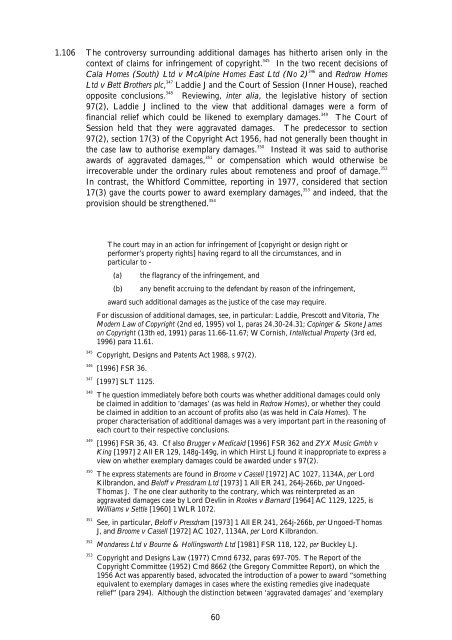Aggravated, Exemplary and Restitutionary ... - Law Commission
Aggravated, Exemplary and Restitutionary ... - Law Commission
Aggravated, Exemplary and Restitutionary ... - Law Commission
Create successful ePaper yourself
Turn your PDF publications into a flip-book with our unique Google optimized e-Paper software.
1.106 The controversy surrounding additional damages has hitherto arisen only in the<br />
context of claims for infringement of copyright. 345<br />
In the two recent decisions of<br />
Cala Homes (South) Ltd v McAlpine Homes East Ltd (No 2) 346<br />
<strong>and</strong> Redrow Homes<br />
Ltd v Bett Brothers plc, 347<br />
Laddie J <strong>and</strong> the Court of Session (Inner House), reached<br />
opposite conclusions. 348<br />
Reviewing, inter alia, the legislative history of section<br />
97(2), Laddie J inclined to the view that additional damages were a form of<br />
financial relief which could be likened to exemplary damages. 349<br />
The Court of<br />
Session held that they were aggravated damages. The predecessor to section<br />
97(2), section 17(3) of the Copyright Act 1956, had not generally been thought in<br />
the case law to authorise exemplary damages. 350<br />
Instead it was said to authorise<br />
awards of aggravated damages, 351<br />
or compensation which would otherwise be<br />
irrecoverable under the ordinary rules about remoteness <strong>and</strong> proof of damage. 352<br />
In contrast, the Whitford Committee, reporting in 1977, considered that section<br />
17(3) gave the courts power to award exemplary damages, 353<br />
<strong>and</strong> indeed, that the<br />
provision should be strengthened. 354<br />
The court may in an action for infringement of [copyright or design right or<br />
performer’s property rights] having regard to all the circumstances, <strong>and</strong> in<br />
particular to -<br />
(a) the flagrancy of the infringement, <strong>and</strong><br />
(b) any benefit accruing to the defendant by reason of the infringement,<br />
award such additional damages as the justice of the case may require.<br />
For discussion of additional damages, see, in particular: Laddie, Prescott <strong>and</strong> Vitoria, The<br />
Modern <strong>Law</strong> of Copyright (2nd ed, 1995) vol 1, paras 24.30-24.31; Copinger & Skone James<br />
on Copyright (13th ed, 1991) paras 11.66-11.67; W Cornish, Intellectual Property (3rd ed,<br />
1996) para 11.61.<br />
345 Copyright, Designs <strong>and</strong> Patents Act 1988, s 97(2).<br />
346 [1996] FSR 36.<br />
347 [1997] SLT 1125.<br />
348 The question immediately before both courts was whether additional damages could only<br />
be claimed in addition to ‘damages’ (as was held in Redrow Homes), or whether they could<br />
be claimed in addition to an account of profits also (as was held in Cala Homes). The<br />
proper characterisation of additional damages was a very important part in the reasoning of<br />
each court to their respective conclusions.<br />
349 [1996] FSR 36, 43. Cf also Brugger v Medicaid [1996] FSR 362 <strong>and</strong> ZYX Music Gmbh v<br />
King [1997] 2 All ER 129, 148g-149g, in which Hirst LJ found it inappropriate to express a<br />
view on whether exemplary damages could be awarded under s 97(2).<br />
350 The express statements are found in Broome v Cassell [1972] AC 1027, 1134A, per Lord<br />
Kilbr<strong>and</strong>on, <strong>and</strong> Beloff v Pressdram Ltd [1973] 1 All ER 241, 264j-266b, per Ungoed-<br />
Thomas J. The one clear authority to the contrary, which was reinterpreted as an<br />
aggravated damages case by Lord Devlin in Rookes v Barnard [1964] AC 1129, 1225, is<br />
Williams v Settle [1960] 1 WLR 1072.<br />
351 See, in particular, Beloff v Pressdram [1973] 1 All ER 241, 264j-266b, per Ungoed-Thomas<br />
J, <strong>and</strong> Broome v Cassell [1972] AC 1027, 1134A, per Lord Kilbr<strong>and</strong>on.<br />
352 Mondaress Ltd v Bourne & Hollingsworth Ltd [1981] FSR 118, 122, per Buckley LJ.<br />
353 Copyright <strong>and</strong> Designs <strong>Law</strong> (1977) Cmnd 6732, paras 697-705. The Report of the<br />
Copyright Committee (1952) Cmd 8662 (the Gregory Committee Report), on which the<br />
1956 Act was apparently based, advocated the introduction of a power to award “something<br />
equivalent to exemplary damages in cases where the existing remedies give inadequate<br />
relief” (para 294). Although the distinction between ‘aggravated damages’ <strong>and</strong> ‘exemplary<br />
60
















